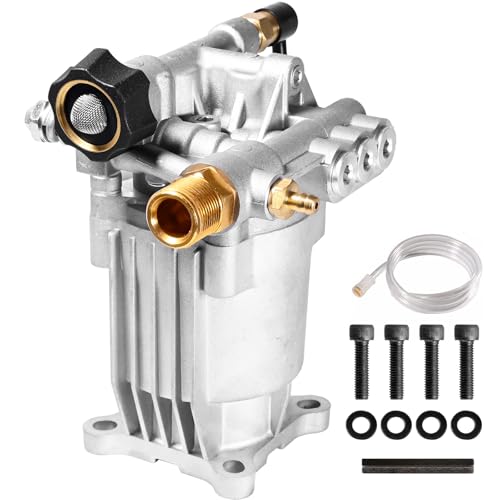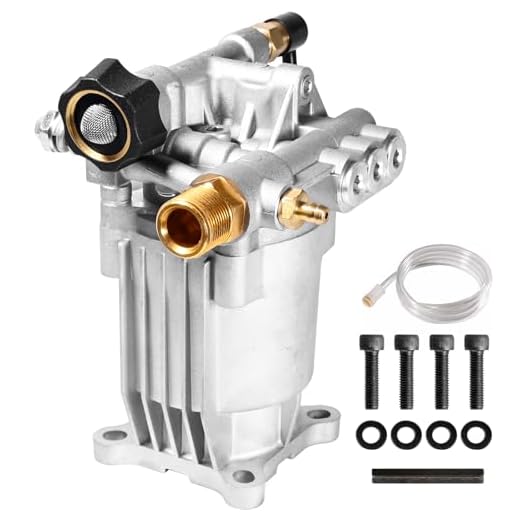Blog
Where Is Choke On Gcv Honda Pressure Washer

When it comes to using a GCV Honda pressure washer, one of the most common questions that users have is “where is the choke?” It’s a valid question, considering that the choke is an important component of the engine’s starting process.
The choke is typically located on the side of the engine, near the carburetor. It is a small lever or button that can be moved to different positions depending on the engine’s needs. The purpose of the choke is to control the amount of air that enters the engine during the starting process.
If you’re having trouble finding the choke on your GCV Honda pressure washer, it’s important to consult the owner’s manual for your specific model. The manual will provide detailed instructions on where exactly the choke is located and how to properly operate it.
Once you locate the choke, using it is relatively simple. When starting the engine, you will need to move the choke to the “closed” or “on” position. This restricts the airflow and allows for a richer fuel mixture, which is necessary for a cold start. Once the engine has warmed up, you can gradually move the choke to the “open” or “off” position to allow for more air and a leaner fuel mixture.
Problems with Choke on GCV Honda Pressure Washer
The choke on a GCV Honda pressure washer can sometimes cause problems, preventing the engine from starting or running properly. The choke is designed to restrict the airflow to the carburetor, increasing the fuel concentration for an easier start in cold conditions. However, if the choke is not functioning correctly, it can lead to various issues.
1. Choke Stuck in the Open Position
If the choke lever is stuck in the open position, the engine may struggle to start or run smoothly. The open choke allows too much air into the carburetor, causing the fuel-to-air mixture to be too lean. This can result in poor combustion and engine stalling.
2. Choke Stuck in the Closed Position
If the choke lever is stuck in the closed position, the engine will likely flood with an excessive amount of fuel. This can cause the spark plug to become soaked, making it difficult for the engine to ignite. The engine may crank but not start, or it may run rough and emit black smoke.
To resolve problems with the choke on a GCV Honda pressure washer, try the following steps:
- Inspect the choke lever and ensure it is not stuck, damaged, or misaligned.
- Clean the choke plate and linkage to remove any dirt or debris that may be causing it to stick.
- Check the choke spring tension and adjust it if needed.
- If the choke lever and linkage appear to be in good condition, inspect the carburetor for any clogs or blockages that may be affecting the choke’s operation.
- If necessary, consider replacing the choke assembly or seeking professional assistance.
Note: It is essential to consult the owner’s manual or contact a qualified technician for detailed instructions on troubleshooting and repairing the choke on your specific GCV Honda pressure washer model.
Common issues with the choke mechanism
The choke mechanism on a GCV Honda pressure washer can sometimes experience issues that prevent it from functioning properly. Understanding these common issues can help you troubleshoot and resolve the problem quickly.
1. Stuck choke lever
One common issue is a stuck choke lever. This can happen due to dirt, debris, or corrosion building up on the lever, making it difficult to move. To fix this, try cleaning the lever with a mild detergent or lubricating it with a silicone-based lubricant. If the lever still doesn’t move smoothly, you may need to replace it.
2. Choke not fully closing
Another issue is when the choke does not fully close. This can result in an engine that is difficult to start or runs poorly. Check if there is any obstruction preventing the choke plate from fully closing, such as debris or a misaligned choke plate. Cleaning the choke plate and ensuring it is properly aligned should resolve this issue.
3. Choke plate not opening
Sometimes, the choke plate does not open fully even after the engine has started. This can cause the engine to run poorly or stall. Check for any obstructions or binding that may prevent the choke plate from opening. If necessary, clean the choke plate and ensure it moves freely. Lubricating the mechanism can also help prevent future issues.
4. Improper adjustment
Incorrect adjustment of the choke mechanism can also be a common issue. If the choke is not set correctly, it can lead to starting problems or poor engine performance. Refer to the owner’s manual for the proper choke adjustment procedure and follow it carefully. Adjusting the choke to the manufacturer’s specifications should resolve any issues.
By understanding these common issues with the choke mechanism on a GCV Honda pressure washer, you can effectively troubleshoot and fix any problems you may encounter. Regular maintenance, including cleaning and lubrication, will help prevent these issues from occurring in the future.
How to troubleshoot choke problems
If you’re having trouble with the choke on your GCV Honda pressure washer, there are a few steps you can take to troubleshoot and fix the issue. Here are some things to try:
1. Check the position of the choke: Make sure the choke is in the correct position. If it’s not fully closed or fully open, it may cause the engine to run poorly or not start at all.
2. Clean the choke: Over time, dirt and debris can build up on the choke, causing it to become stuck or not operate properly. Use a small brush or compressed air to clean the choke thoroughly.
3. Check the choke linkage: The choke linkage connects the choke to the engine. If it’s loose or damaged, it may prevent the choke from operating correctly. Inspect the linkage for any signs of wear or damage and replace if necessary.
4. Inspect the choke plate: The choke plate is responsible for regulating the flow of air into the engine. If it’s dirty or damaged, it may cause the engine to run poorly. Clean the choke plate or replace it if necessary.
5. Check the fuel mixture: If the choke is not providing the correct amount of fuel to the engine, it may cause starting or running issues. Make sure the fuel mixture is correct and adjust if necessary.
6. Consult the user manual: If you’ve tried the above troubleshooting steps and are still experiencing issues with the choke, consult the user manual for your specific model of GCV Honda pressure washer. The manual may have additional troubleshooting steps or specific instructions for your machine.
By following these troubleshooting steps, you should be able to diagnose and fix any problems you’re experiencing with the choke on your GCV Honda pressure washer. Remember to always follow safety guidelines and consult a professional if you’re unsure or uncomfortable performing any repairs.
Importance of maintaining a functional choke
The choke on a GCV Honda pressure washer plays a vital role in the start-up process and overall performance of the machine. It is responsible for regulating the air and fuel mixture that goes into the engine, especially when starting the pressure washer from a cold start.
1. Starting the engine
When starting a cold engine, the choke needs to be engaged to create a richer fuel mixture. This is necessary because a cold engine requires more fuel to start properly. By engaging the choke, it restricts the airflow into the carburetor, creating a richer mixture with a higher concentration of fuel. This helps the engine start more easily and prevents it from sputtering or stalling out.
2. Cold weather conditions
In colder weather conditions, the choke becomes even more important. Cold temperatures can affect the combustion process, making it harder for the engine to start. By using the choke, it provides the necessary fuel enrichment to compensate for the unfavorable weather conditions and ensure a smooth start-up.
Additionally, a functional choke allows the engine to warm up properly during cold weather. It helps to regulate the air and fuel mixture as the engine warms up, preventing any damage from running too rich or too lean.
Regular maintenance of the choke is crucial to ensure its proper functionality. This includes cleaning any debris or dirt that may clog the choke, as well as checking for any damage or wear that may require repair or replacement.
In conclusion, maintaining a functional choke is essential for a GCV Honda pressure washer. It ensures proper starting of the engine, especially in cold weather conditions, and helps to regulate the air and fuel mixture for optimal performance. Regular maintenance and care for the choke will help prolong the lifespan of the pressure washer and prevent any malfunctions.
Question-answer
Where is the choke on a GCV Honda pressure washer?
The choke on a GCV Honda pressure washer is usually located near the air filter. It is a lever or switch that you can move to control the amount of air entering the engine.
How do I find the choke on my GCV Honda pressure washer?
To find the choke on your GCV Honda pressure washer, locate the air filter on the engine. The choke is usually located near the air filter and can be identified as a lever or switch. Move the lever or switch to control the amount of air entering the engine.
Why is it important to know the location of the choke on a GCV Honda pressure washer?
It is important to know the location of the choke on a GCV Honda pressure washer because the choke controls the amount of air entering the engine. If the choke is not properly adjusted, the engine may not start or may run poorly. By knowing where the choke is located, you can easily adjust it to ensure proper engine performance.
What can I do if I can’t find the choke on my GCV Honda pressure washer?
If you can’t find the choke on your GCV Honda pressure washer, refer to the owner’s manual or contact the manufacturer for assistance. They will be able to provide you with the specific location of the choke on your model. It is important to locate and properly adjust the choke for optimal engine performance.
Can I use a GCV Honda pressure washer without using the choke?
In most cases, it is recommended to use the choke on a GCV Honda pressure washer for easier starting and optimal engine performance. However, depending on the specific model and conditions, it may be possible to start and use the pressure washer without using the choke. Refer to the owner’s manual or contact the manufacturer for guidance on using your specific model without the choke.
Where is the choke on GCV Honda pressure washer?
The choke on a GCV Honda pressure washer is usually located near the air filter or carburetor. It is a lever or a small control that can be moved to adjust the amount of air entering the engine, which helps with starting the engine in colder weather.
How do I find the choke on my GCV Honda pressure washer?
To find the choke on your GCV Honda pressure washer, you can refer to the user manual that came with the machine. It will have detailed instructions on locating and operating the choke. If you don’t have the manual, you can look for a lever or control near the air filter or carburetor that can be moved to adjust the air intake.
Recent Posts
-
How To Connect Soap To Honda Pressure Washer
June 28, 2024 -
A To Z Pressure Washing Scam
June 27, 2024 -
How To Pressure Wash Your Home With A Garden Hose
June 27, 2024 -
Where Can I Buy Honda Pressure Washer Parts
June 25, 2024






